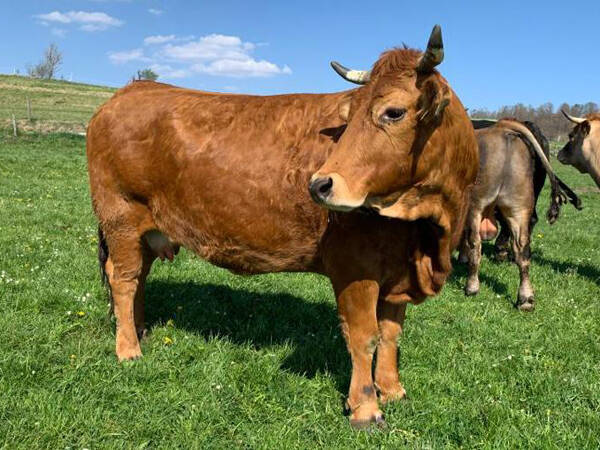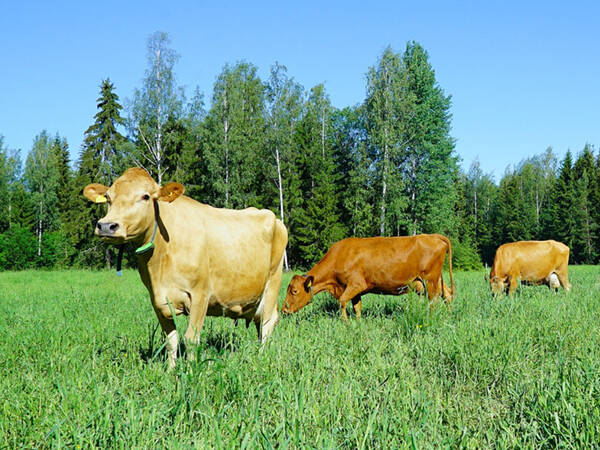Bos taurus
IUCN
LCBasic Information
Scientific classification
- name:Bos taurus
- Scientific Name:Bos taurus,Cattle, European cattle
- Outline:Ungulata
- Family:Artiodactyla Bovidae Bos
Vital signs
- length:1.2-1.3m
- Weight:147-1363kg
- lifetime:12-15years
Feature
Strong physique, mainly used for eating, labor, and some events
Distribution and Habitat
Like most domestic animals, domestic cattle (Bos taurus) can be found in many parts of the world. The wild ancestors of domestic cattle are native to North Africa, Europe, and South Asia.
Domestic cattle are common and can be found throughout the world. Domestic cattle are born and raised on rangelands. Rangelands are large areas of natural herbaceous or shrubby vegetation that are accessible to domestic or wild herbivorous animals. Rangelands are grasslands, shrublands, woodlands, wetlands, and deserts grazed by domestic or wild animals. Types of rangelands include tall and short grass prairies, desert grasslands and shrublands, woodlands, savannas, scrublands, steppes, and tundra. Rangelands do not include forests lacking grazing understory vegetation, barren deserts, croplands, or land covered by solid rock, concrete, and/or glaciers.
Appearance
Domestic cattle are large, sturdy animals. The weight ranges from 147-1363 kg and the height ranges from 1.2-1.3 meters. The body is covered with short hair, the color of which varies from black to white, reddish brown and brown. Domestic cows have short necks and drooping chins. They have two hollow horns and a long tufted tail. Domestic cows do not have upper incisors, but instead have a thick tooth pad. The jaws are designed for a circular grinding motion for grinding rough vegetation.
Depending on the breed, cows weigh from 200-600 kg (largest over 1000 kg); bulls weigh from 300-900 kg (largest 1,600 kg). Calves weigh from 18-45 kg (sometimes not more than 60 kg) at birth; bull calves weigh 1-3 kg more than female cows. The weight of a newborn calf is about 20-40 kg. The calf can stand on its own soon after birth and can be weaned in about 2 to 3 months.
There is only one udder. Under normal circumstances, there are 4 nipples. Some mutant cows have extra nipples. The udder of
Details
Domestic cattle (scientific name: Bos taurus) are also known as domesticated cattle or aurochs. They are a general term for many domesticated animals in the order Artiodactyla, family Bovidae, and genus Bos. There are 1.3 billion domestic cattle on Earth today, with a total of 897 breeds. They are generally used for food (meat and milk) or for labor.

Domestic cattle are social animals that live in groups called herds. Each herd is led by a dominant male, who is the only male that mates with other females. They usually like to eat and rest in groups, and individuals also communicate through actions and sounds. For example, butting heads is an aggressive, hostile behavior, while licking each other's body is a friendly behavior. Calves begin to learn this communication process a few months after birth, and abnormal behaviors increase when the density of the herd is too high or too sparse.
Domestic cattle have a loose concept of group hierarchy, and in fact this system was not proposed by scholars until the mid-20th century. Generally speaking, larger and older cows have higher status, and the herd is organized according to dominance levels. Each individual must obey those cows above them in the hierarchy. Calves adopt the identity of mothers in the hierarchy. Females usually protect their young and chase anything that threatens them. Females also share parental care in the group. Unlike primates, the hierarchy of domestic cattle does not seem to be determined by fighting. Moreover, the hierarchy system is generally stable and generally changes only with changes in the composition of members. The mechanism of its hierarchy establishment still needs to be studied. The offspring of individuals with higher status seem to gain higher status if they can maintain a closer relationship with their mothers. It is speculated that this may be because the offspring learn leadership behavior from their mothers. The behavior of the head cow will be imitated by other cattle in the group, and it will have priority in feeding and resting. There is a corresponding hierarchy system not only between individuals in the same herd, but also between different herds. If the free-range herd has fewer resources, the behavior of fighting between them for resources will increase significantly.

The behavior of cattle can be divided into individual behavior and social behavior. The former is the behavior that cattle complete to meet their physiological and psychological needs, while the latter is the communication behavior between different individuals. Newborn calves like to play with other calves, and even adult cattle need to maintain a certain amount of activity. To clean themselves, cattle lick their fur. For places that their tongues cannot reach, they scrape with their hooves, other objects, or lick each other. To repel mosquitoes, cattle often wag their tails and shake their bodies slightly. Cattle are docile animals and have a close relationship with humans after long-term domestication. Normally, cattle rarely show aggressive behavior towards humans, and they generally show curious behavior when encountering strangers.
Domestic cattle feed on grass, stems, and other herbaceous plant materials. An average cow can consume about 70 kg of grass in 8 hours a day. Cows wrap grass around their tongues and cut it with their lower teeth. Domestic cattle are ruminants. Ruminants have a special digestive system that can break down the relatively indigestible plant materials they consume. Cows have a four-chambered stomach, which includes the rumen, reticulum, omasum (commonly known as cattle louvers), and abomasum. The grass passes through the rumen, where it mixes with special bacteria. From the rumen it moves to the reticulocytes, where it is further broken down. The partially digested food, called the cud, is re-digested and chewed. It is then swallowed and passes into the omasum and abomasum, where digestive enzymes break it down further and absorb the nutrients. The digestion process takes 70-100 hours, one of the slowest passage rates of all animals. This method of digestion allows ruminants to get as much nutrition as possible from this plant material.
Members of the domestic cattle become sexually mature at about 13 months of age and usually breed at 13-26 months of age. Polygyny is observed in natural environments, with dominant males competing for the opportunity to breed with females. After fertilization, the gestation period is about 9 months, and healthy calves weigh about 40 kg at birth.

Cows mainly provide beef, milk and their products. Cow dung still contains a lot of unabsorbed energy. In the past, the dung of cows and other livestock was an important fertilizer directly applied to the fields. Dried cow dung could be used as fuel or even to build simple houses. The promotion of chemical fertilizers and the improvement of people's hygiene awareness have reduced the significance of cow dung as fertilizer. It has gradually been replaced by fermented animal manure, which can also produce biogas for combustion during the fermentation process. The treated cow dung can be used as animal feed again. Cows are also a reserve resource. In many places on the earth, domestic cattle are still used to pull carts or plow land. To this day, in many places in East Asia and Southeast Asia, cattle traction is still used for farming. In some areas, in order to reduce the demand for fossil fuels, the demand for farming cattle has increased.
Because domestic cattle are strong, they can also be used in many sports. Bullfighting is very popular in the Iberian Peninsula and Latin America. The professional bull riding competition originated in the United States has now spread to Brazil, Mexico, Australia and other places. Bull racing is popular on Madura Island in Indonesia. Although this sport is far less famous than horse racing and dog racing in other regions, it is of great significance in the culture of local people. Switzerland also has traditional competitions of bulls fighting bulls. Bullfighting is the quintessence of Spain. There are bullrings in all cities of Spain, with a total of more than 400. The Ronda bullring, built in 1779, is one of the important and earliest bullrings in Spain. The Madrid Vitas bullring, built in 1934, has about 30,000 seats and is the largest bullring in Spain.
Domestic cattle have many other uses. Culturally, they can provide weddings and transactions, as well as rituals such as feasts and sacrifices. Ancient Chinese fortune-tellers used fire to burn tortoise shells and cow shoulder blades and observed the cracks for divination. The oracle inscriptions engraved on them were called oracle bones. Generals in the cold weapon era would use fire bull formations to charge the enemy, with famous examples such as Hannibal and Tian Dan. Cow bones are also a hard tool and weapon in the hands of primitive people. Due to their hard texture and smooth surface, cow bones and horns can also be used as materials for carving. The collagen extracted from the boiled cow bones has good biocompatibility and can be used as a hemostatic agent, drug carrier, cell culture medium, cosmetic surgery, etc. in medicine.
Protect wild animals and eliminate game.
Maintaining ecological balance is everyone's responsibility!








